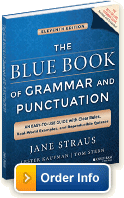|
Welcome to your GrammarBook.com e-newsletter.
|
“I am the proud owner of The Blue Book of Grammar and Punctuation. Please continue to keep us legitimate in our speech.”
—Peggy W.
“GrammarBook.com is invaluable as a guide to ensure that my work is professional and correct.”
—Jim T.
“I love your
e-newsletters. I have referred them to English-teaching colleagues and assigned quizzes to students for extra credit. Best of all, your newsletters solved a couple of grammar differences with my husband! They’re fun and interesting. I always learn something.”
—Arlene C.
|
|
|
Numbers: Words or Numerals?
The topic of when to write numbers out and when to use numerals concerns and confounds a lot of people.
America’s two most influential style and usage guides have different approaches: The Associated Press Stylebook recommends spelling
out the numbers zero through nine and using numerals thereafter—until one million is reached. Here are four examples of how to write numbers above
999,999 in AP style: 1 million; 20 million; 20,040,086; 2.7 trillion.
The
Chicago Manual of Style
recommends spelling out the numbers zero through one hundred and using figures thereafter—except for whole numbers used in combination with hundred, thousand, hundred thousand, million, billion, and beyond (e.g., two hundred; twenty-eight thousand; three hundred thousand; one million). In Chicago style, as opposed to
AP style, we would write four hundred, eight thousand, and twenty million with no numerals—but like AP, Chicago style
would require numerals for 401; 8,012; and 20,040,086.
There are only a handful of rules for writing numbers that virtually everyone agrees on. Two major ones: Numbers beginning sentences must be written out (Eight thousand twelve people attended the concert). Years (8 B.C., 2015) are expressed in numerals. But spelling out numbers vs. using numerals mostly comes down to policies and
preferences that vary from publisher to publisher.
The topic causes further confusion because exceptions to just about every rule or practice crop up constantly. For instance, She walked 3 miles; Add 4 teaspoons of salt; Timmy is 5 years old; and The car is 6 feet wide are all correct in AP style, despite contradicting AP’s
own rule of spelling out numbers between zero and nine.
Chicago endorses the following sentence “for the sake of consistency”: A mixture of buildings—one of 103 stories, five of more than 50, and a dozen of only 3 or 4—has been suggested for the area. Chicago
explains why it does not spell out 50, 3, and 4: “If according to rule you must use numerals for one of the numbers [103] in a given category, use them for all in that category.” But why, then, are one, five, and a dozen written
out? Because “items in one category may be given as numerals and items in another spelled out.”
AP’s approach to numbers is far less nuanced than Chicago’s. This may be because the Associated Press Stylebook is targeted to
newspapers and magazines, which toil in a world of deadlines. There simply isn’t time to get sidetracked by numerical niceties when your article is
due in three hours.
Here is a sentence from a profile that appeared in a big-city newspaper: “He has delivered a tutorial about the First, Second, Fourth, Fifth, Sixth,
Ninth and 10th amendments to the Constitution.” Note the glorious inconsistency of “10th,” which would make Chicago Manual of Style disciples apoplectic.
But AP style stipulates “10th,” not “Tenth,” and that’s that. It may look odd, but is the sentence not clear and unambiguous?
When it comes to the arcane, convoluted subject of writing numbers, there’s something refreshing about AP’s streamlined approach.
Because of the e-newsletter’s large readership, please submit your English usage questions through GrammarBook.com’s “Grammar Blog.” |
|
Free BONUS Quiz for You!
[[firstname]], because you are a subscriber to the newsletter, you get access to one of the Subscription Members-Only Quizzes. Click here to take a Writing Numbers Quiz and get your scores and explanations instantly!
More Good News for Quiz Subscribers
We are pleased to announce that we have added even more quizzes to help you challenge yourself, your students, and your staff. We added quizzes to existing categories and created some new categories such as “Confusing Verbs,” “Subjunctive Mood,” “Comprise,” “Sit vs. Set vs. Sat,” and “Spelling.”
We reviewed and strengthened every quiz on our website to ensure consistency with the rules and guidelines contained in our eleventh edition of The Blue Book of Grammar and Punctuation.
If you think you have found an error in a quiz, please email us at help@grammarbook.com.

“So convenient … hundreds of quizzes in one click.”
[[firstname]], Subscribe to receive hundreds of English usage quizzes not found anywhere else!
- Take the quizzes online or download and copy them.
- Get scored instantly.
- Find explanations for every quiz answer.
- Reproduce the quizzes to your heart’s content.
- EASY to use.
- No software to download.
- No setup time.
- A real person to help you if you have any questions!
Instructors and Employers: we make your life easier!
- Assign quizzes to your students or employees.
- Students log in from anywhere.
- Scores are tallied and compiled for you.
- You decide whether to let students see their own scores and quiz explanations.
- Let GrammarBook.com take the hassle out of teaching English!
“Fun to test my skills!”
“The explanations really help … thanks!”
Your choice: Subscribe at the $29.95 or $99.95 level ($30 off - previously $129.95).
“I download the quizzes for my students who don’t have computer access.”
Subscribe today to receive hundreds of English usage quizzes not found anywhere else!
“Makes learning English FUN!”
 |
Don’t need all the quizzes at once?
You can now purchase the same quizzes individually for ONLY 99¢ each. Purchase yours here. |

Get Yours Today!
Get Amazon’s No. 1 Best-seller in Four Categories!
No. 1 in Grammar
No. 1 in Reading
No. 1 in Lesson Planning
No. 1 in Vocabulary |
The Blue Book of Grammar
and Punctuation
by Jane Straus, Lester Kaufman, and Tom Stern
The Authority on English Grammar!
Eleventh Edition Now Available
Have You Ordered Your Copy Yet?
An indispensable tool for busy professionals, teachers, students, homeschool families, editors, writers, and proofreaders.
Available in print AND as an e-Book! Over 2,000 copies are purchased every month!
Order Your Copy Today!
- Hundreds of Grammar, Punctuation, Capitalization, and Usage Rules
- Real-World Examples
- Spelling / Vocabulary / Confusing Words
- Quizzes with Answers
The publisher is extending its discount offer until August 31, 2015! If you live in the United States or Canada, order the new edition of The Blue Book
through Wiley.com and get 30 percent off and FREE shipping. Simply go to bit.ly/1996hkA and use discount code E9X4AYY.
For those of you who live outside the U.S. and Canada, although the publisher is not able to offer free shipping, you will get 35 percent off to help offset your shipping costs. Simply go to bit.ly/1996hkA and use discount code E9X4A. |
 Wordplay Wordplay
The buck does funny things when the does are present.
A seamstress and a sewer fell down into a sewer line.
To help with planting, the farmer taught his sow to sow.
Learn all about who and whom, affect and effect, subjects and verbs, adjectives and adverbs, commas, semicolons, quotation marks, and much more by just sitting back and enjoying these easy-to-follow lessons. Tell your colleagues (and boss), children, teachers, and friends. Click here to watch. |




 Wordplay
Wordplay
